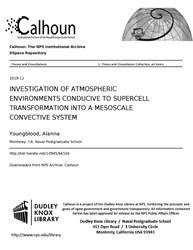File:INVESTIGATION OF ATMOSPHERIC ENVIRONMENTS CONDUCIVE TO SUPERCELL TRANSFORMATION INTO A MESOSCALE CONVECTIVE SYSTEM (IA investigationofa1094564104).pdf

Original file (1,275 × 1,650 pixels, file size: 2.81 MB, MIME type: application/pdf, 50 pages)
Captions
Captions
Summary[edit]
| INVESTIGATION OF ATMOSPHERIC ENVIRONMENTS CONDUCIVE TO SUPERCELL TRANSFORMATION INTO A MESOSCALE CONVECTIVE SYSTEM
( |
||
|---|---|---|
| Author |
Youngblood, Alanna |
|
| Title |
INVESTIGATION OF ATMOSPHERIC ENVIRONMENTS CONDUCIVE TO SUPERCELL TRANSFORMATION INTO A MESOSCALE CONVECTIVE SYSTEM |
|
| Publisher |
Monterey, CA; Naval Postgraduate School |
|
| Description |
The environmental factors that contribute to supercell thunderstorms transitioning into mesoscale convective systems (MCSs) are poorly understood. Numerous studies have investigated these phenomena separately, but few have studied the interconnected dynamics that cause a transition between supercells and MCSs. This lack of knowledge significantly affects the ability to forecast severe weather impacts associated with each system, such as severe lightning, wind, hail, flooding, and tornadoes. Previous studies highlight four specific elements needed for the formation of both supercells and MCSs: low-level vertical wind shear, upper-level vertical wind shear, convective available potential energy (CAPE), and relative humidity (RH). Using a high-resolution cloud model, multiple combinations of the aforementioned environmental factors were investigated to determine which distinct combination contributed to a supercell’s initial development and MCS transition. Through data analysis focusing on areas of convectivity, potential temperature (theta) perturbations, and total mass flux, it was concluded that MCS growth from supercells is favored in environments with highest values of CAPE and RH, with low-level shear and upper-level shear inducing minor impacts. These results will facilitate refinement of MCS transition models. Subjects: supercell; mesoscale convective system; MCS; MCSs; severe weather; tornado; tornadoes; supercell transition; mid-latitude severe weather |
|
| Language | English | |
| Publication date | December 2019 | |
| Current location |
IA Collections: navalpostgraduateschoollibrary; fedlink |
|
| Accession number |
investigationofa1094564104 |
|
| Source | ||
| Permission (Reusing this file) |
This publication is a work of the U.S. Government as defined in Title 17, United States Code, Section 101. Copyright protection is not available for this work in the United States. | |
Licensing[edit]
| Public domainPublic domainfalsefalse |
This work is in the public domain in the United States because it is a work prepared by an officer or employee of the United States Government as part of that person’s official duties under the terms of Title 17, Chapter 1, Section 105 of the US Code.
Note: This only applies to original works of the Federal Government and not to the work of any individual U.S. state, territory, commonwealth, county, municipality, or any other subdivision. This template also does not apply to postage stamp designs published by the United States Postal Service since 1978. (See § 313.6(C)(1) of Compendium of U.S. Copyright Office Practices). It also does not apply to certain US coins; see The US Mint Terms of Use.
|
 | |
| This file has been identified as being free of known restrictions under copyright law, including all related and neighboring rights. | ||
https://creativecommons.org/publicdomain/mark/1.0/PDMCreative Commons Public Domain Mark 1.0falsefalse
File history
Click on a date/time to view the file as it appeared at that time.
| Date/Time | Thumbnail | Dimensions | User | Comment | |
|---|---|---|---|---|---|
| current | 05:19, 22 July 2020 |  | 1,275 × 1,650, 50 pages (2.81 MB) | Fæ (talk | contribs) | FEDLINK - United States Federal Collection investigationofa1094564104 (User talk:Fæ/IA books#Fork8) (batch 1993-2020 #19274) |
You cannot overwrite this file.
File usage on Commons
The following page uses this file:
Metadata
This file contains additional information such as Exif metadata which may have been added by the digital camera, scanner, or software program used to create or digitize it. If the file has been modified from its original state, some details such as the timestamp may not fully reflect those of the original file. The timestamp is only as accurate as the clock in the camera, and it may be completely wrong.
| Short title | INVESTIGATION OF ATMOSPHERIC ENVIRONMENTS CONDUCIVE TO SUPERCELL TRANSFORMATION INTO A MESOSCALE CONVECTIVE SYSTEM |
|---|---|
| Image title | |
| Author | Youngblood, Alanna |
| Software used | Youngblood, Alanna |
| Conversion program | Adobe PDF Library 11.0 |
| Encrypted | no |
| Page size | 612 x 792 pts (letter) |
| Version of PDF format | 1.4 |

